
|
Hog Island sheepAbout 200 years ago, a flock of sheep was established on Hog Island, one of Virginia's barrier islands located off its Eastern Shore. The sheep were already native to the area and are believed to have had a substantial amount of Merino blood in them. There were occasional subsequent introductions to the population, the last being in 1953, when a Hampshire ram was taken to the island. In 1974, the island was sold to The Nature Conservancy, which decided to remove all the sheep and cattle. |

|
Hu sheepHu sheep originated from Mongolian sheep. They are distributed in the Zhejiang Jiangsu provinces of China and the suburbs of Shanghai. Hu sheep are well recognized for their beautiful wavy lambskins, early sexual maturity, aseasonal breeding, prolificacy, and the adaptability to a hot and humid climate. Hu sheep are raised indoors all year round. The lambskins taken from lambs slaughtered within the day of birth have distinctive wave-like stripes which are still retained after processing. |

|
Icelandic sheepThe modern Icelandic Sheep is a direct descendant of the sheep brought to Iceland by the early Viking settlers in the ninth and tenth century. They are of the North European Short Tailed type, related to such breeds as the Finnsheep, Romanov, and Shetland. A major gene controlling prolificacy has been identified in the Icelandic breed. This gene exhibits action similar to the gene found in the Booroola Merino. |
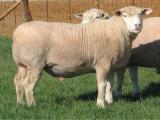
|
Ile de France sheepThe Ile de France is the result of crossing the English Leicester and the Rambouillet. The breed was originally known as the Dishley Merino. |

|
Imroz sheepThe Imrov is among the smallest sheep breeds in Turkey. They are raised for meat, milk, and wool. Animals are predominantly white, with black marks around the mouth, nose and eyes, on the ears and rarely on the tip of the legs. |

|
INRA 401 sheepThe creation of the INRA 401 sheep bloodline began in France in 1970, after a series of experiments crossing the Berrichon du Cher x Romanov which began in 1963 with the Romanov breed. |

|
Jacob sheepThe Jacob is a unique breed. Their most striking features are their four horns, two vertical center horns and two side horns curling along side of the head, and their spotted black and white fleece which is prized by hand spinners and weavers. The Jacob is an old, unimproved breed whose origins are obscure to say the least. Some say they are the result of the earliest recorded selective breeding as referenced in the Bible. |

|
Jezersko-Solcava sheepJezerskosolflorinavska sheep resulted from the crossbreeding of native white sheep with the Bergamasca sheep and with the Padova sheep. It resembles the Austrian Bergschaf that has a similar origin. The breed got its name after the breeding centers of Jezersko and Solflorinava. Its head has a convex profile and hanging ears. Its legs are long and strong. This breed is very convenient for lamb production in the Alpine and Pre-Alpine region. |

|
Kamieniec sheepKamieniec are a Polish breed. They were created in the years 1954-1965 in the Kamieniec farm of the Breeding Center in Susz, near Olsztyn. The starting point was a flock of primitive ewes of the Pomeranian type, from individual farms in the regions of Gdansk and Koszalin or brought from settlers from the East. They were initially crossed with Leine and Texel rams, and then mated to Romney Marsh rams. |

|
Karakul sheepThe Karakul may be the oldest breed of domesticated sheep. Archeological evidence indicates the existence of the Persian lambskin as early as 1400 B.C. and carvings of a distinct Karakul type have been found on ancient Babylonian temples. Native to the plains of Central Asia, Karakuls differ radically in conformation from most other American breeds. They are of the fat broad tailed type of sheep. In their large tail is stored fat, a source of nourishment, similar in function to the camel's hump. |

|
Katahdin sheepThe Katahdin is an improved breed of hair sheep, the first hair breed to meet North American industry standards for carcass quality. The Katahdin is a cross between British meat breeds, notably the Suffolk, African Hair sheep, specifically the St. Croix, and later the Wiltshire Horn. They were developed in the 1950's by amateur geneticist Michael Piel and take their name from Mt. Katahdin in Maine where the Piel farm was located. |

|
Kelso sheepThe Kelso is one of several composite breeds developed in New Zealand. Unlike traditional breeds, which are bred for appearance as well as productivity, composites are bred for productive traits alone. The Kelso is continually being upgraded and modified to meet changing market needs. |
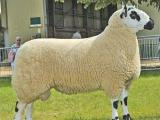
|
Kerry Hill sheepThe Kerry Hill breed is from Powys, on the English/Welsh borders, and it derives its name from the village of Kerry, near Newtown. There are records of this distinctive breed in this area dating back to 1809, and the first Flock Book was published in 1899. Registered Kerry Hill Sheep can be found throughout the British Isles, Ireland, and Holland. |

|
Kivircik sheepThe Kivircik is found in northwestern Turkey, where it is kept for milk and meat production. Their fleece is of carpet-wool type, but the wool is of better quality than the wool of all other indigenous breeds in Turkey. |
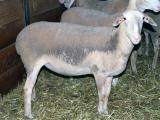
|
Lacaune sheepThe Lacaune is the most numerous sheep breed in France. It has been selected in France for increased milk production under a sophisticated selection program incorporating artificial insemination, milk recording, and progeny testing of sires for longer than any other dairy sheep breed in the world. |

|
Landschaf sheepThis member of the heath-sheep landrace is a cross between German and Dutch heath sheep and a marsh sheep. Since 1934, it has been bred in the northern German Emsland area, especially in the county of Bentheim. The highly endangered, frugal Bentheimer Landschaf is used for landscape preservation. It is the largest of the German heath and moor sheep with long legs and hard hoofs. |

|
Leicester Longwool sheepThe Leicester Longwool was important to the development of other long wool breeds and has made a large contribution to the sheep industries in Australia and New Zealand. The breed originated in the Leicester region of England and although it is a very old breed, Robert Bakewell, a pioneer in the field of animal genetics, is given credit for improving it during the 18th century. |
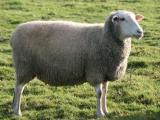
|
Leine sheepThe Leine breed comes from the region of Nordheim (Hannover), in particular from the Leine river valley (hence the name). |

|
Limousine sheepLimousine sheep orginated in the region of France which gave them their name. |

|
Lincoln sheepThe Lincoln is one of the world's largest breeds of sheep. Its fleece is the heaviest, longest-stapled and most lustrous of any breed in the world. |

|
Lleyn sheepLleyn sheep originate from the Lleyn peninsula in Wales and until recently were a relatively unfamiliar breed of sheep in the UK. Over the past 10 years the Lleyn breed has caught the eye of many farmers, and now Lleyn sheep can be found almost all over the Country.The Lleyn ewe is renowned for her tremendous mothering ability, ease of lambing, longevity, and prolificacy. |
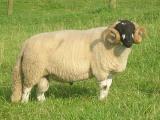
|
Lonk sheepThe Lonk has been bred on the Lancashire and Yorkshire Pennines from time immemoria. It is an aristocrat by virtue of origins as ancient as the hills on which it roams. It is one of the largest native hill breeds in England. The face is pure black and white, and the legs are speckled black and white. Both sexes are horned. |
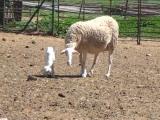
|
Manchega sheepThe Manchega sheep comes from the Entrefino breed and has a double production use: milk and sheepmeat. Among this breed, there are two accepted varieties: black and white. The latter one makes up more than 90% of the animals. The average milk production is 100 liters (26.4 gallons) per animal a year, being markedly seasonal during the months of April, May and June. |

|
Manx Loaghtan sheepThe Manx Loaghtan is found on the Isle of Man off the coast of Great Britain. It is member of the Northern Short-tailed group, similar to the Hebridean, but slightly larger. It's wool is chocolate brown with paler tips. The Manx Loaghtan is descended from the primitive sheep once found throughout Scotland and the coastal islands of Britain. |
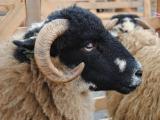
|
Masham sheepMasham sheep have been bred for over a centry on the hill farms in the Northern Counties of England. They are produced by crossing a Teeswater ram onto either a Dalesbred or Swaledale ewe, both hardy hill breeds. |
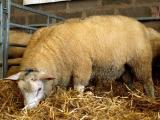
|
Meatlinc sheepThe Meatlinc is a British breed, in the Terminal Sire category, developed from a breeding program originated by Henry Fell in the early 1960’s.Originally a mixture of chosen individuals from five breeds, two British and three French, the Meatlinc evolved as a result of many years of rigorous and disciplined selection based on performance recording carried out under strictly commercial conditions. |

|
Meatmaster sheepIn the early 1990's, determined to utilize the advantages of the indigenous fat-tailed hair breeds and realizing the huge gap between the fat-tailed breeds and the well-muscled British and European breeds and the need for a truly good pure hair breed with good meat qualities, a group of South African farmers decided to develop a composite breed. |

|
Miniature Cheviot sheepCheviot sheep originated in the Cheviot Hills between England and Scotland. They were introduced to the U.S. in 1838. Border Cheviots are small, hardy sheep that spend their lives on the moors. In the U.S., they have become larger than their ancestors from the UK, so the Brecknock Hill Miniature Cheviot registry was formed to preserve the original size. The registry recently dropped "Brecknock Hill" from its name to differentiate American Miniature Cheviots from the Brecknock Hill Cheviots that originated in Wales and are slightly different. |

|
Mirror sheepThe Mirror Sheep has a characteristic head design. Besides its otherwise white color, it has black eye marks, black ear points, and a black nostril. A medium-sized sheep, Mirror Sheep are undemanding compared to other sheep. |

|
Montadale sheepThe Montadale was developed in the United States from Cheviot and Columbia crosses. E.H. Mattingly, a well-known commercial lamb buyer is given credit for developing the breed. His idea was to bring together the qualities of big western-white faced sheep and the popular mutton characteristics of Midwestern sheep. His result was a good meat type, dual- purpose animal with the head and legs free of wool and with the stylish appearance and agile body of the Cheviot. |
| 1 | 2 | 3 | 4 | 5 | 6 | 7 | 8 |